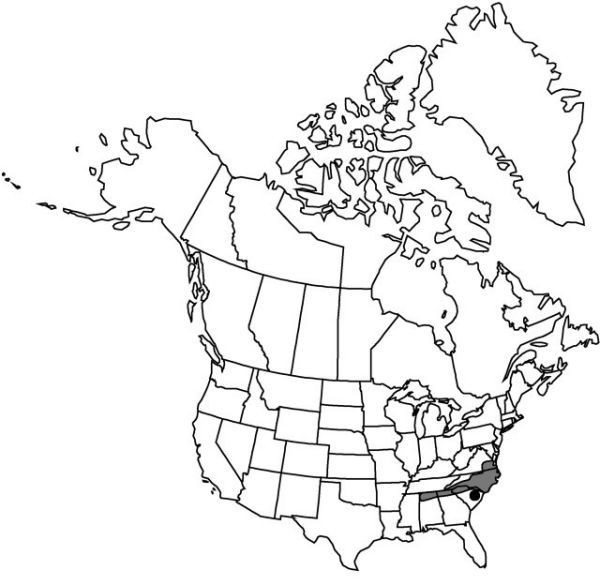Difference between revisions of "Sisyrinchium capillare"
Bull. Torrey Bot. Club 26: 608. 1899.
FNA>Volume Importer |
imported>Volume Importer |
||
| (6 intermediate revisions by 2 users not shown) | |||
| Line 6: | Line 6: | ||
|place=26: 608. 1899 | |place=26: 608. 1899 | ||
|year=1899 | |year=1899 | ||
| + | }} | ||
| + | |special_status={{Treatment/ID/Special_status | ||
| + | |code=E | ||
| + | |label=Endemic | ||
}} | }} | ||
|basionyms= | |basionyms= | ||
| Line 23: | Line 27: | ||
|elevation=0–200 m | |elevation=0–200 m | ||
|distribution=Ala.;Ga.;N.C.;S.C.;Va. | |distribution=Ala.;Ga.;N.C.;S.C.;Va. | ||
| − | |discussion=<p>Sisyrinchium capillare has, at times, been considered synonymous with S. albidum (e.g., D. T. MacRoberts 1984). The very narrow, almost wingless stems and glabrous filaments will help distinguish it from S. albidum, which is much more wide-ranging.</p> | + | |discussion=<p><i>Sisyrinchium capillare</i> has, at times, been considered synonymous with <i>S. albidum</i> (e.g., D. T. MacRoberts 1984). The very narrow, almost wingless stems and glabrous filaments will help distinguish it from <i>S. albidum</i>, which is much more wide-ranging.</p> |
|tables= | |tables= | ||
|references= | |references= | ||
| Line 32: | Line 36: | ||
-->{{#Taxon: | -->{{#Taxon: | ||
name=Sisyrinchium capillare | name=Sisyrinchium capillare | ||
| − | |||
|authority=E. P. Bicknell | |authority=E. P. Bicknell | ||
|rank=species | |rank=species | ||
| Line 46: | Line 49: | ||
|publication title=Bull. Torrey Bot. Club | |publication title=Bull. Torrey Bot. Club | ||
|publication year=1899 | |publication year=1899 | ||
| − | |special status= | + | |special status=Endemic |
| − | |source xml=https:// | + | |source xml=https://bitbucket.org/aafc-mbb/fna-data-curation/src/2e0870ddd59836b60bcf96646a41e87ea5a5943a/coarse_grained_fna_xml/V26/V26_726.xml |
|genus=Sisyrinchium | |genus=Sisyrinchium | ||
|species=Sisyrinchium capillare | |species=Sisyrinchium capillare | ||
Latest revision as of 21:16, 5 November 2020
Herbs, perennial, cespitose, yellowish green to olive when dry, to 4.5 dm, not glaucous. Stems apparently simple, wiry, wings present as slight ridges, 0.5–1 mm wide, glabrous, margins minutely denticulate, similar in color and texture to stem body. Leaf blades glabrous, bases not persistent in fibrous tufts. Inflorescences usually paired, closely subtended by long, bractlike leaf that often obscures first (inner) inflorescence, sessile or second (outer) with branch to 6.6 mm; spathes often purplish, glabrous, keels entire; outer 12.1–14.7 mm, 0.9 mm shorter to 2.7 mm longer than inner, usually tapering evenly towards apex, margins distinct or connate basally to 1.5 mm; inner with keel straight or evenly curved, hyaline margins 0.2–0.4 mm wide, apex acute to occasionally obtuse, ending 0.2–1.4 mm proximal to green apex. Flowers: tepals pale blue to bluish violet, bases yellow; outer tepals 7.7–12 mm, apex emarginate, aristate; filaments connate ± entirely, glabrous; ovary similar in color to foliage. Capsules tan or light brown, ± globose, 2–3.3 mm, glabrous; pedicel loosely erect or spreading. Seeds globose to obconic, lacking obvious depression, 0.8–1.2 mm, rugulose.
Phenology: Flowering spring.
Habitat: Open woods
Elevation: 0–200 m
Distribution

Ala., Ga., N.C., S.C., Va.
Discussion
Sisyrinchium capillare has, at times, been considered synonymous with S. albidum (e.g., D. T. MacRoberts 1984). The very narrow, almost wingless stems and glabrous filaments will help distinguish it from S. albidum, which is much more wide-ranging.
Selected References
None.